What is Sahaj Return?
In an attempt to help ease the burden of filing returns for taxpayers, the GST Council has decided to institute a new return filing system. Sahaj return is a simplified quarterly return for small taxpayers who deal with B2C supplies. It will be put into practice from October 2019.
Who should file Sahaj return?
Sahaj return must be mandatorily filed by small taxpayers who have a turnover of Rs. 5 crores maximum and primarily deal with B2C supplies.
How to file Sahaj Return?
Sahaj return form consists of 7 parts in total and collects information like the taxpayer’s general details, amendments to details on taxable outward and inward supplies that attract reverse charge, amendments to inward supplies to claim ITC, information on interest and late fee, and payments of tax. The Sahaj return form cannot be filed on its own. It must be filed along with 5 other forms namely, GST ANX-1, GST ANX-2, GST ANX-1A, GST RET-2A, and GST PMT-08. In this guide you will be reading about the following topics:
Form GST ANX-1
GST ANX-1 is an annexure for reporting details of outward and inward supplies that are applicable for reverse-charge. The information entered in this form will be used to auto-populate some of the fields in the next form, ANX-2. Taxpayers are required to upload this form on a monthly basis, before filing the actual Sahaj return form. Let’s look at the form in detail:
Part 1 and 2: General details

The first two parts of this annexure are for your general details: GSTIN, full legal name, trade name, ARN (Application Reference Number), and the date of filing.
Part 3: Details of outward and inward supplies for which reverse charge applies
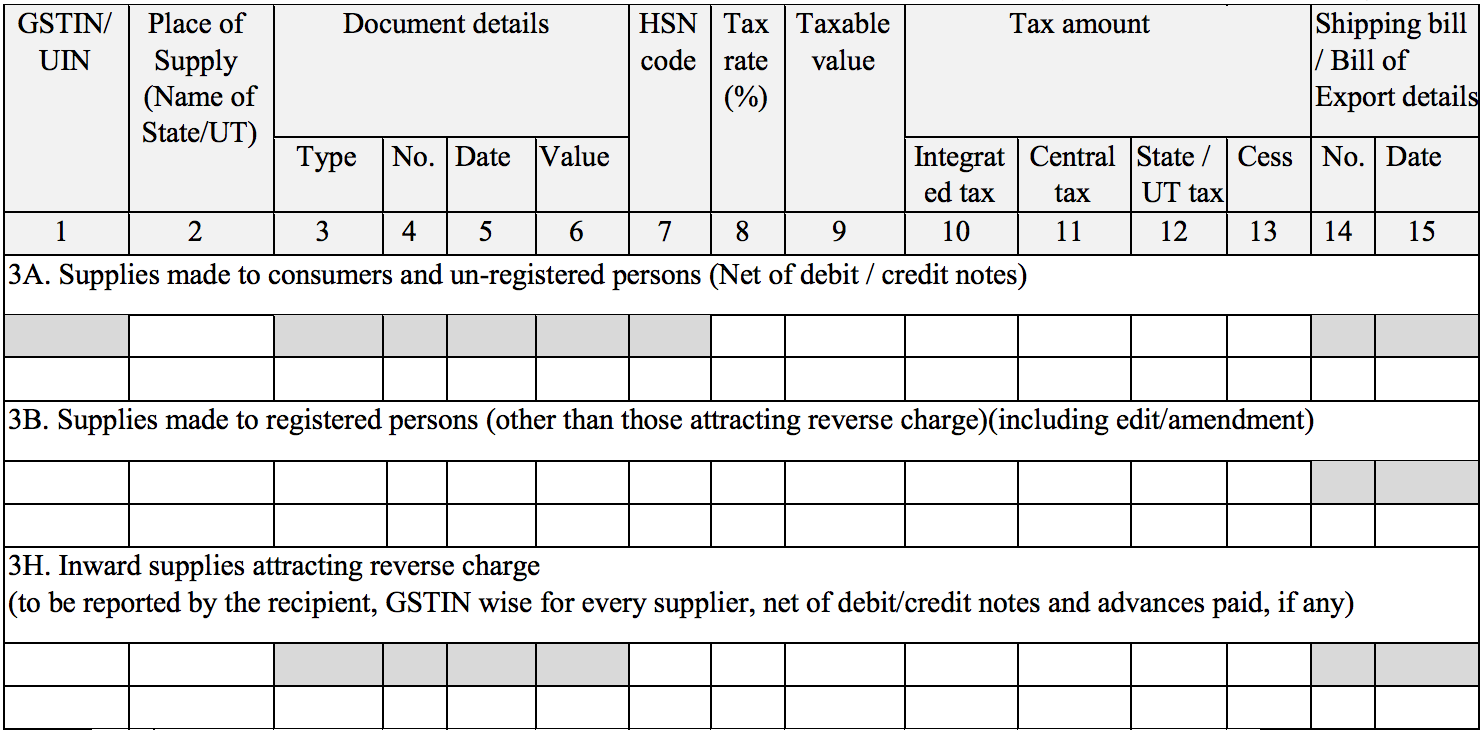
In this section, you are required to fill in your GSTIN or UIN, place of supply and relevant document details, HSN code, tax rates, taxable value, tax amounts, and details regarding your shipping bill or bill of export for the following:
Supplies made to your consumers and other un-registered persons.
Supplies made to registered persons, besides those for which reverse-charge applies.
Inward supplies for which reverse-charge applies.
Form GST ANX-2
GST ANX-2 is an annexure for all inward supplies received from a registered person and details of the ITC received. Taxpayers are required to upload this form on a monthly basis, before filing the actual Sugam return form. Let’s look at the form in detail:
Part 1 and 2: General details

The first two parts of this annexure are for your general details: GSTIN, full legal name, trade name, ARN (Application Reference Number), and the date of filing.
Part 3: Inward supplies received from a registered person

This part of the form is for details of inward supplies that you have received from a registered person, besides those supplies for which reverse-charge applies. In this form, you are required to enter the GSTIN of your supplier, their trade name, place of supply, relevant document details, HSN code, tax rates, taxable value, tax amounts, and the status of the form.
Note: The F in the return status column stands for Return Filed and the NF stands for Return Not Filed. Similarly, in the action column, the A stands for Accepted, R stands for Rejected, and P stands for Pending.
Part 4: Summary of ITC
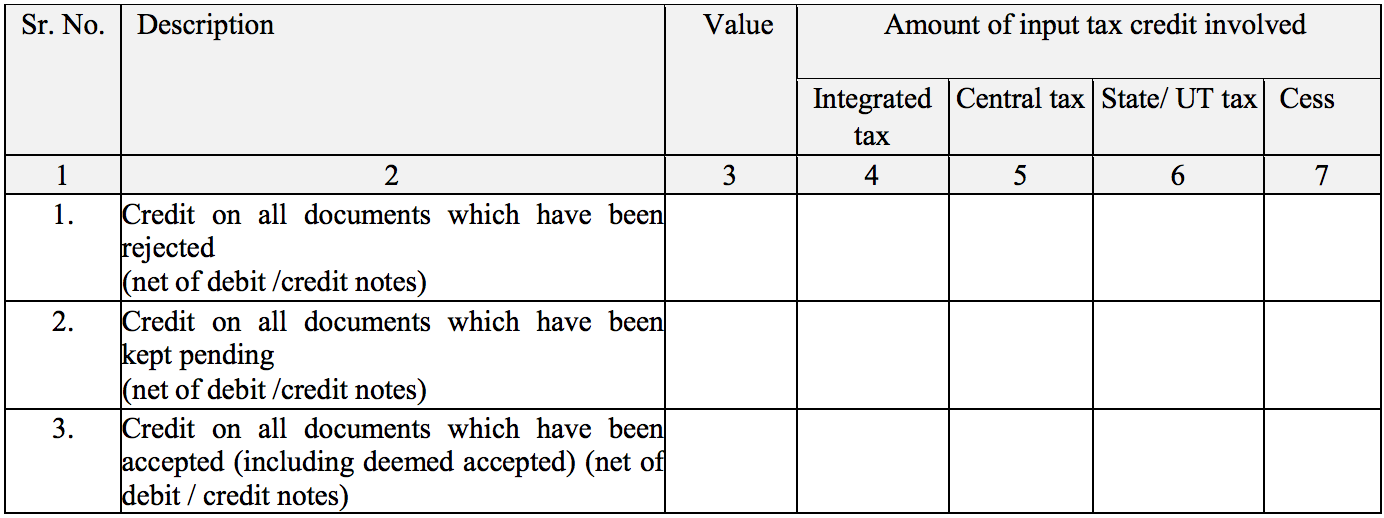
The last part of Form GST ANX-2 is where you are required to enter the value and amounts of ITC involved under integrated tax, CGST, SGST or UGST, and cess tax for the following:
The total amount of credit availed from documents that have been rejected.
The total amount of credit availed from documents that have been marked pending.
The total amount of credit availed from documents that have been accepted.
Form GST RET-2
Form GST RET-2, or the Sahaj return, is a simplified quarterly return meant for small taxpayers having a turnover of up to Rs. 5 crores and dealing with only B2C supplies. Here is a detailed explanation of the form:
Part 1 and 2: General details

The first two parts of the Sahaj return form are for your general details. Enter your GSTIN, full legal name, trade name, ARN (Application Reference Number), and the date of filing.
Part 3: Amendment to summary of outward supplies, inward supplies attracting reverse charge and tax liability
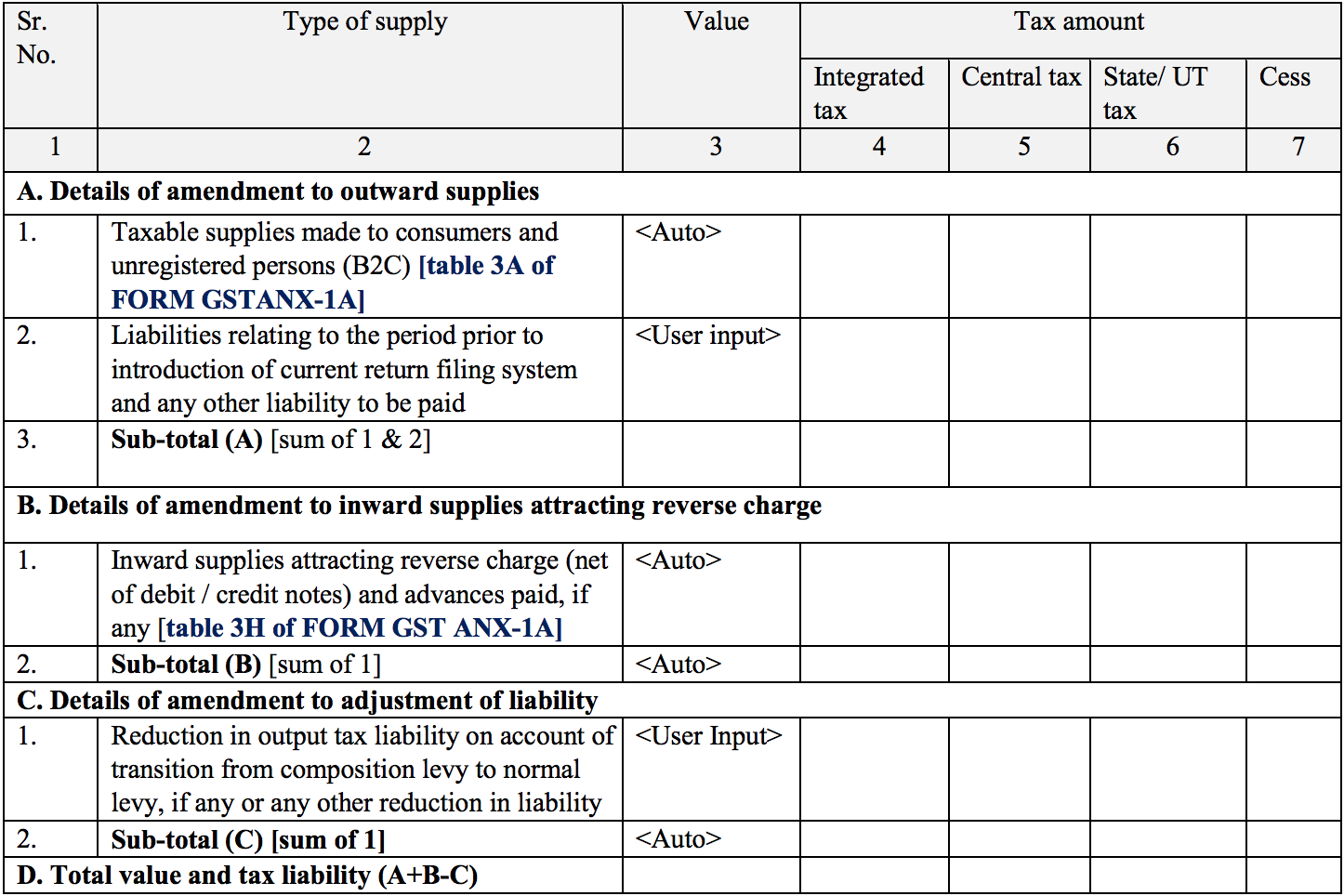
A. Details of amendment to outward supplies
This part of the form is where you are required to fill in details of your outward supplies like the integrated tax, central tax, and cess amount, CGST, SGST, and value of:
The taxable supplies that you have made to your customers and unregistered persons.
The liabilities incurred during the time before the current return filing system was introduced, as well as any other liability incurred.
The total of the above two quantities.
B. Details of amendment to inward supplies attracting reverse-charge
This is where you are required to fill in details of your inward supplies that attract reverse charge. Enter the integrated tax, central tax, cess amount, CGST, SGST, and value of:
The inward supplies for which reverse charges are applicable and advances have been paid, if any apply.
The total of the above values.
C. Details of amendment to adjustment of liability
In this section, you are required to fill in details of your adjustment of liability. Enter the integrated tax, central tax, cess amount, CGST, SGST, and value of:
The amount reduced from output tax liability because of the transition from the composition levy to the normal levy, if any, or any other amount reduced from liability.
The total of the above quantities.
D. Total value and tax liability of A, B, and C
Part 4: Amendment to summary of inward supplies for claiming input tax credit (ITC)
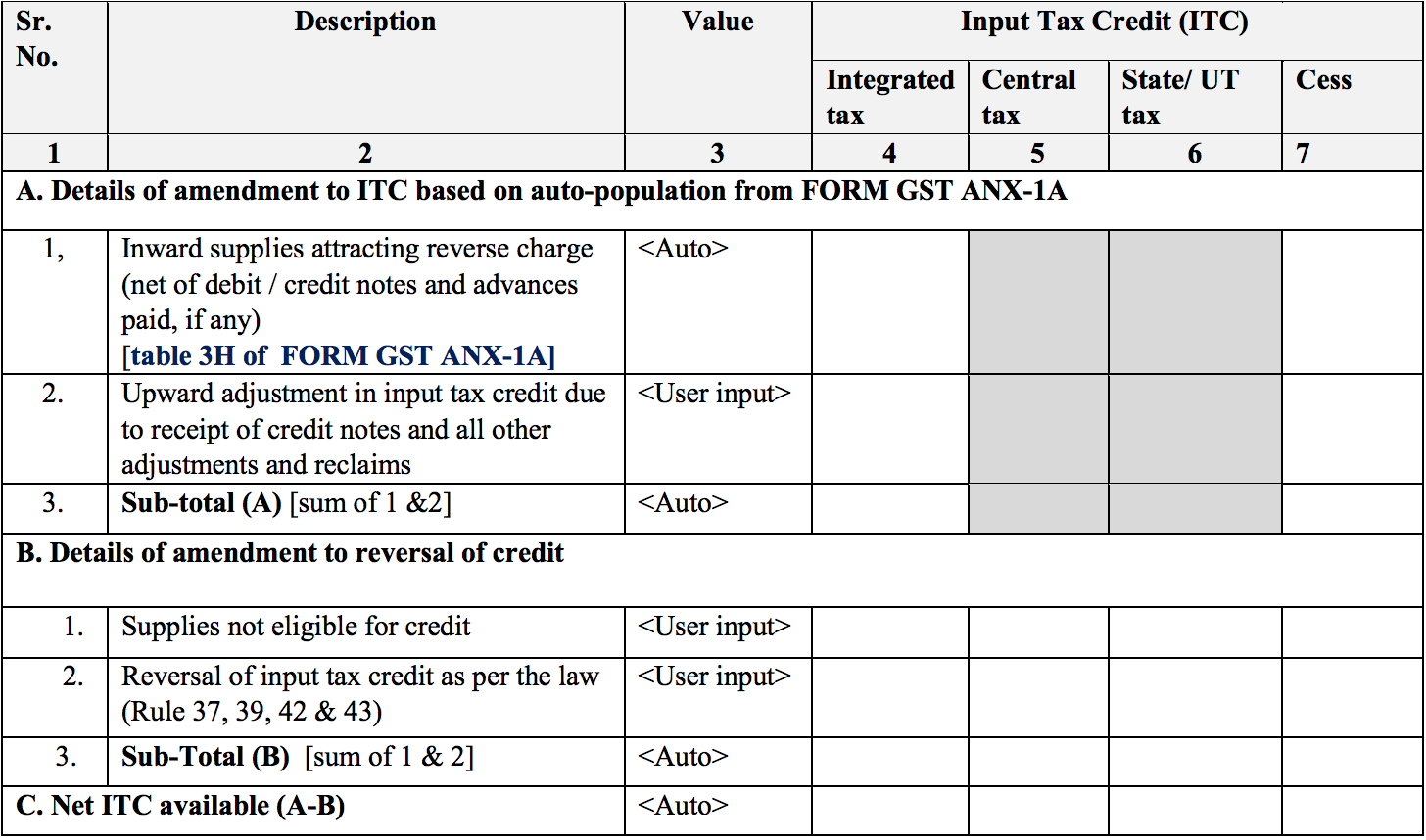
A. Details of amendment to ITC based on auto-population from FORM GST ANX-1A
This is where you are required to fill in details of your inward supplies. Enter the ITC value of your integrated tax, central tax, cess amount, CGST, SGST, and value of:
The inward supplies for which reverse charges are applicable and advances have been paid, if any apply.
The increment in ITC due to any receipt of credit notes or other reclaims.
The total of the above 2 quantities.
B. Details of amendment to reversal of credit
In this section, you are required to enter the details of any adjustments to the reversal of credit. Enter the integrated tax, central tax, cess amount, CGST, SGST, and value of:
Any supplies that you have made that are not eligible for credit.
The reversal of ITC as per GST rules.
The total of the above 2 quantities.
C. Net ITC available
Here you are required to enter the integrated tax, central tax, cess amount, CGST, SGST, and value of your net ITC available, which is the difference of the quantities entered in A and B (A-B).
Part 5: Interest and late fee details
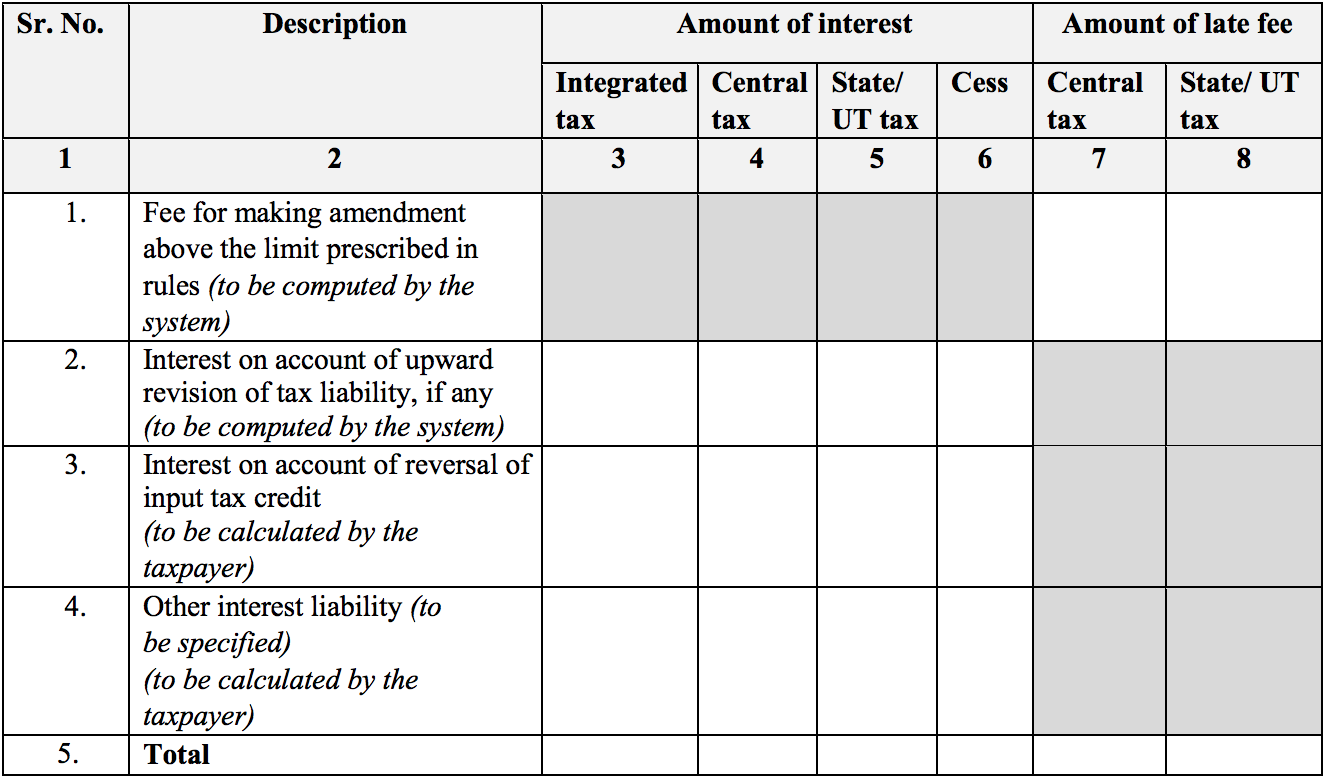
In this section, you are required to fill in details of your interest and late fees for:
Making amendments higher than prescribed by GST rules.
Upward revisions of tax liability, if any.
Any reversal of ITC.
Other interest liabilities that have not been mentioned above.
The total of all the above quantities.
Part 6: Payment of tax
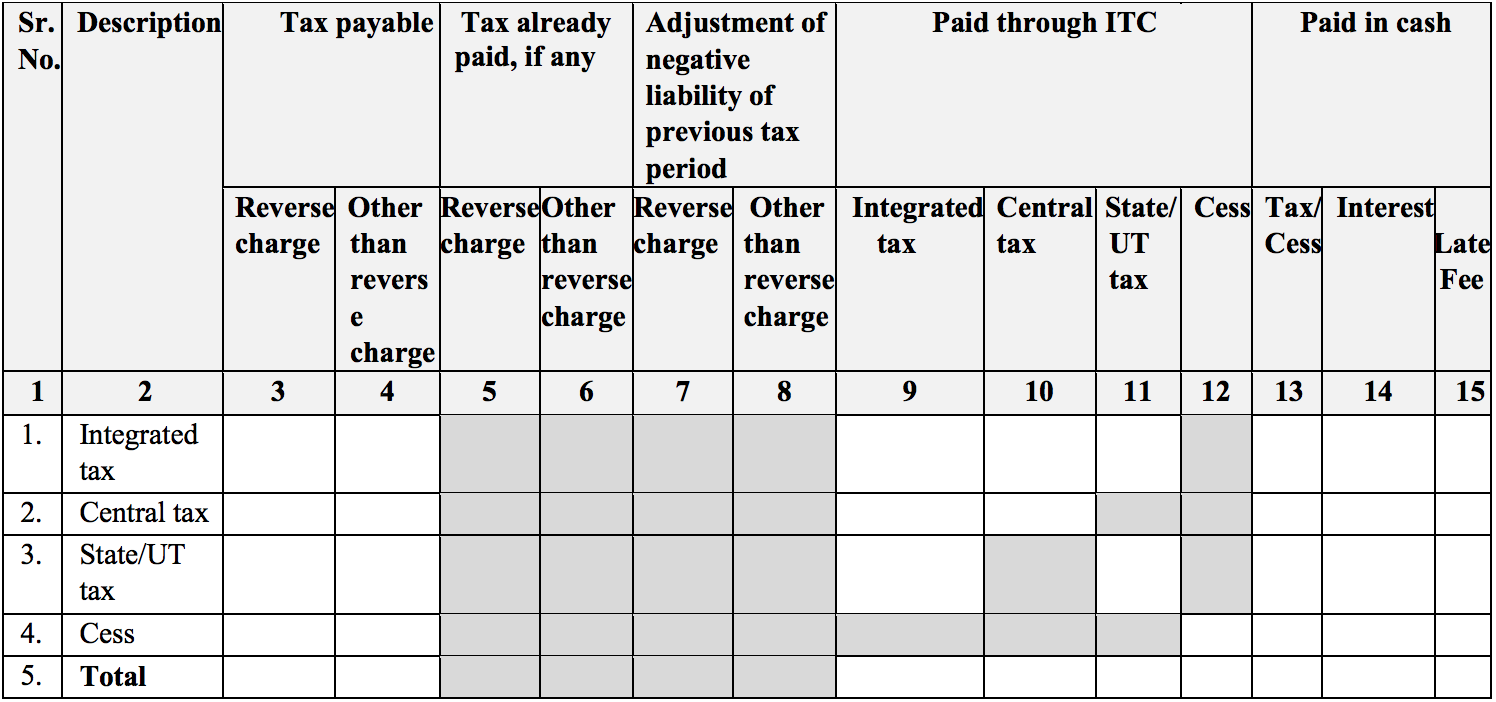
In this part of the form, you are required to enter the values of your payable tax, paid tax, adjustment of negative liability incurred during the previous tax period, payments made through ITC, and payments made in cash for:
Integrated tax
CGST
SGST
Cess
The total of the above quantities.
Part 7: Verification

Filling in and signing the final part of the form will verify and authenticate the return either through a digital signature certificate (DSC) or by using an Aadhar-based signature verification mechanism.
Form GST ANX-1A
Form GST ANX-1A is an amendment for details of both your outward and inward supplies that attract reverse charge. Here is a detailed explanation of the form:
Part 1 and 2: General details

The first two parts of this annexure are for your general details: GSTIN, full legal name, trade name, ARN (Application Reference Number), and the date of filing.
Part 3: Amendment to details of outward and inward supplies that attract reverse charge
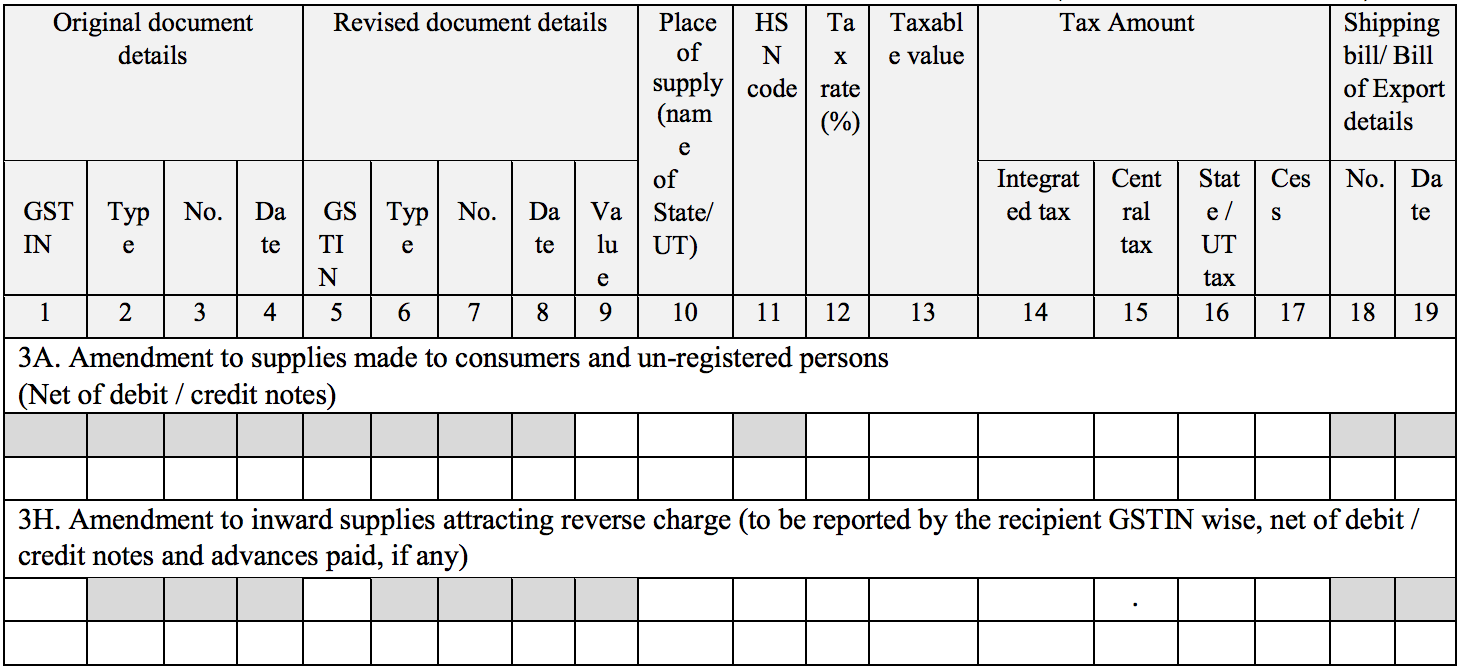
In this section, you are required to enter any changes or amendments to details that were previously entered in Form GST ANX-1. Enter your details related to your original document, revised document, place of supply, HSN code, tax rates, taxable value, tax amounts, and details regarding your shipping bill or bill of export for the following:
Amendment to supplies made to your consumers and other un-registered persons.
Amendment to inward supplies for which reverse charge applies.
FORM GST RET-2A
Form GST RET-2A is an amendment to the quarterly return GST RET-2, also called the Sahaj return. Here is a detailed explanation of each section of the form:
Part 1 and 2: General details

The first two parts of this annexure are for your general details: GSTIN, full legal name, trade name, ARN (Application Reference Number), and the date of filing.
Part 3: Amendment to summary of outward and inward supplies for which reverse charge is applicable
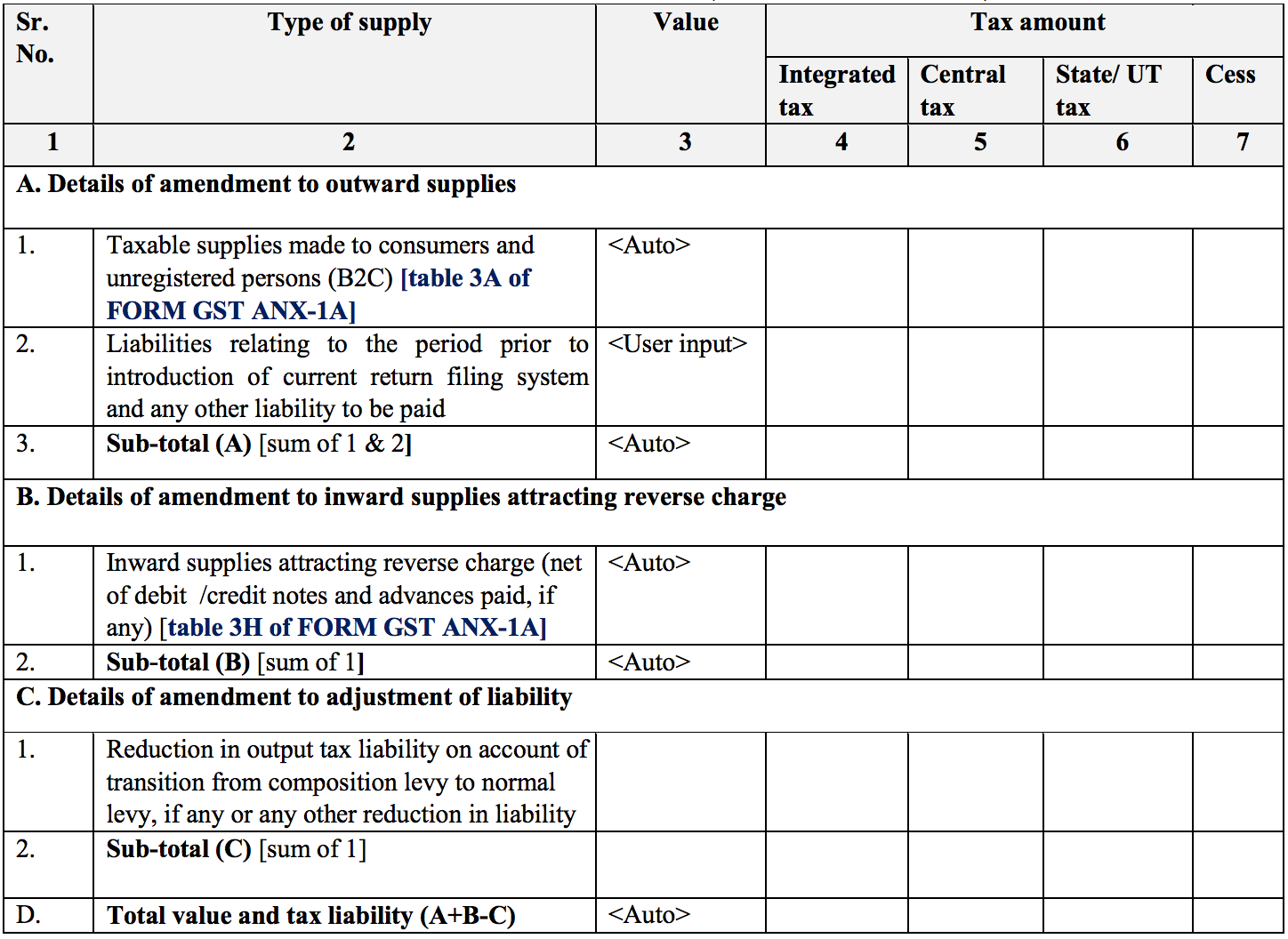
In this part of the form, you are required to provide details regarding any amendments to your outward and inward supplies for which reverse charge applies. The value column alone will be auto-populated with entries made in the previous forms.
A. Details of amendment to outward supplies
Here you are required to enter the amounts of integrated and cess tax, CGST, and SGST/UGST for the following:
The taxable supplies made to B2C consumers and unregistered persons.
Any liabilities accumulated before the introduction of the current return filing system.
The total of the above 2 quantities.
B. Details of amendment to inward supplies attracting reverse charge
In this part, you are required to enter the amounts of integrated and cess tax, CGST, and SGST/UGST for the following:
The inward supplies for which reverse charge applies.
The subtotal of the values mentioned above.
C. Details of amendment to adjustment of liability
Here, you are required to enter the amounts of integrated and cess tax, CGST, and SGST/UGST for the following:
The amount of reduction in output tax liability due to the transition from the composition scheme to the normal scheme, or any other notable reduction in liability.
The subtotal of the above values.
D. Total value and tax liability (A+B+C)
Here you are required to enter the total value of all of the above quantities (the sum of lines A, B, and C).
Part 4: Amendment to summary of inward supplies for claiming ITC
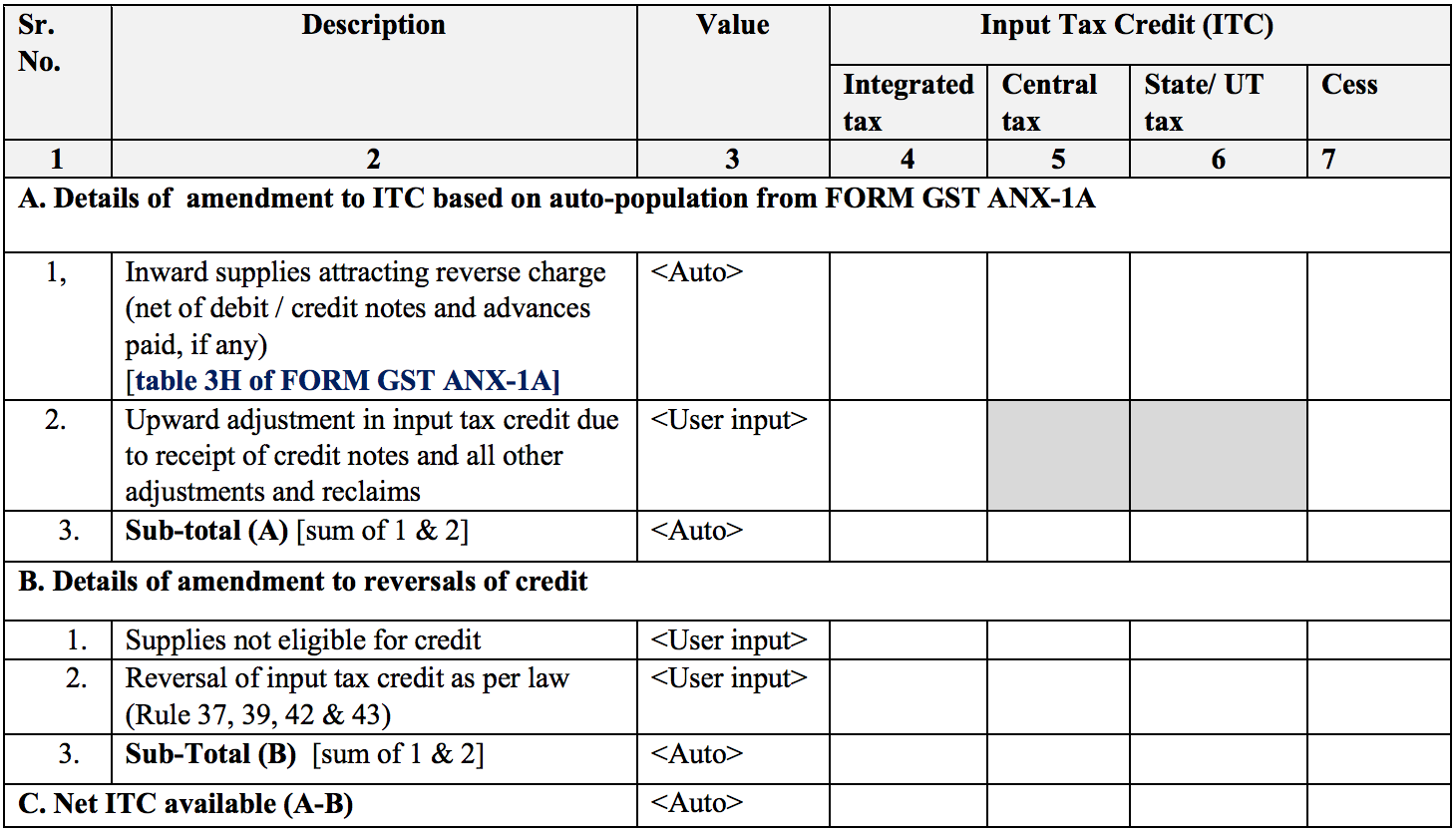
A. Details of amendment to ITC based on auto-population from FORM GST ANX-1A
In this section, you are required to enter the ITC values relevant to the integrated tax, CGST, SGST/UGST, and cess tax for the following:
The inward supplies made for which reverse charge applies.
The upward adjustments in ITC due to receipt of credit notes and all other adjustments and reclaims.
The total of the above 2 quantities.
B. Details of amendment to reversals of credit
Here, you are required to enter the ITC values relevant to the integrated tax, CGST, SGST/UGST, and cess tax for the following:
Those supplies that are not eligible for credit.
The reversal of ITC as per Rules 37, 39, 42, & 43.
The total of the above 2 quantities.
C. Net ITC available (A-B)
Here you are required to enter the net ITC that is available to you. This can be calculated as the difference between the values entered in A and B.
Part 5: Interest and late fee details
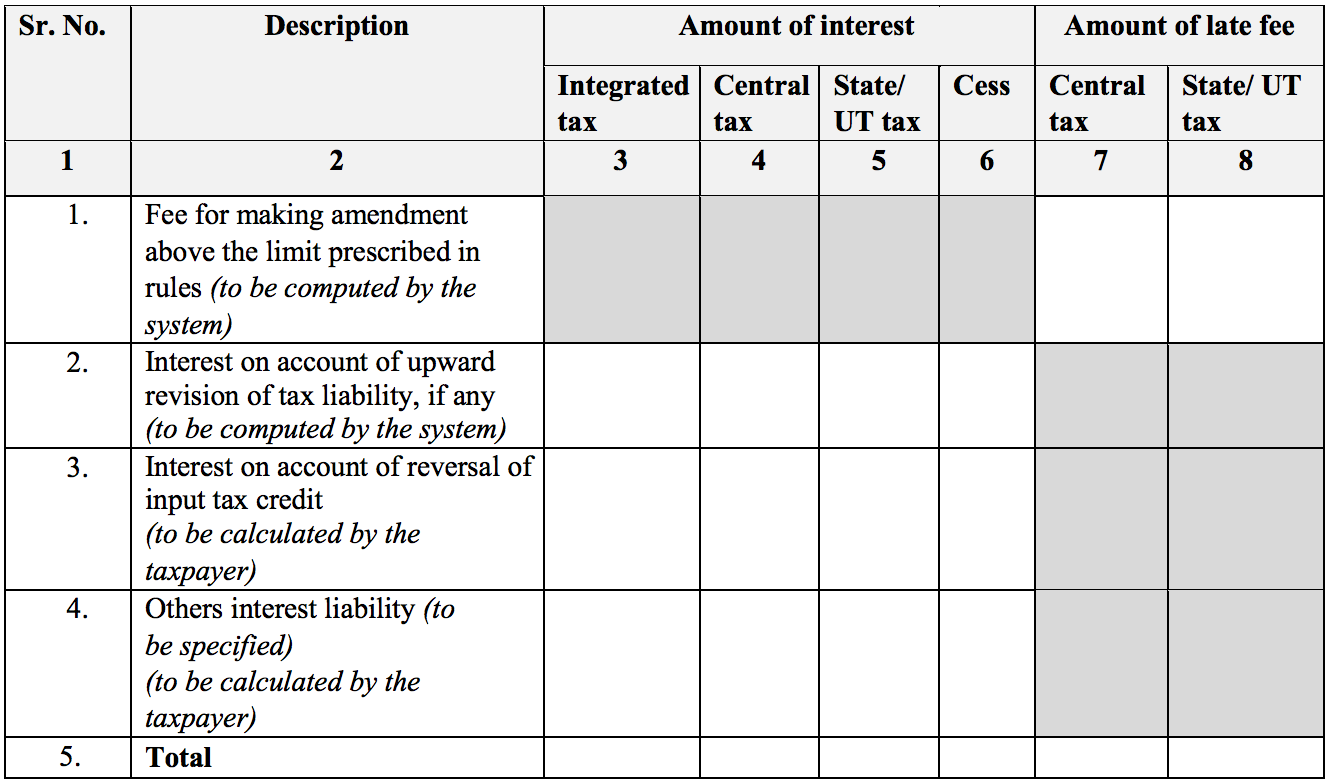
This section is for your interest and late fee details. Here, you are required to enter the amount of interest for your integrated tax, CGST, SGST, and cess tax, along with the relevant amount of late fees under CGST and SGST for the following:
The fee for making any amendment above the limit prescribed in the rules. This value will be computed by the system.
The amount of interest on account of upward revision of tax liability, if any. This value will also be computed by the system.
The amount of interest due to a reversal of ITC. This value must be computed by you. Any other interest liability. This liability must be specified and calculated by you.
Part 6: Payment of tax
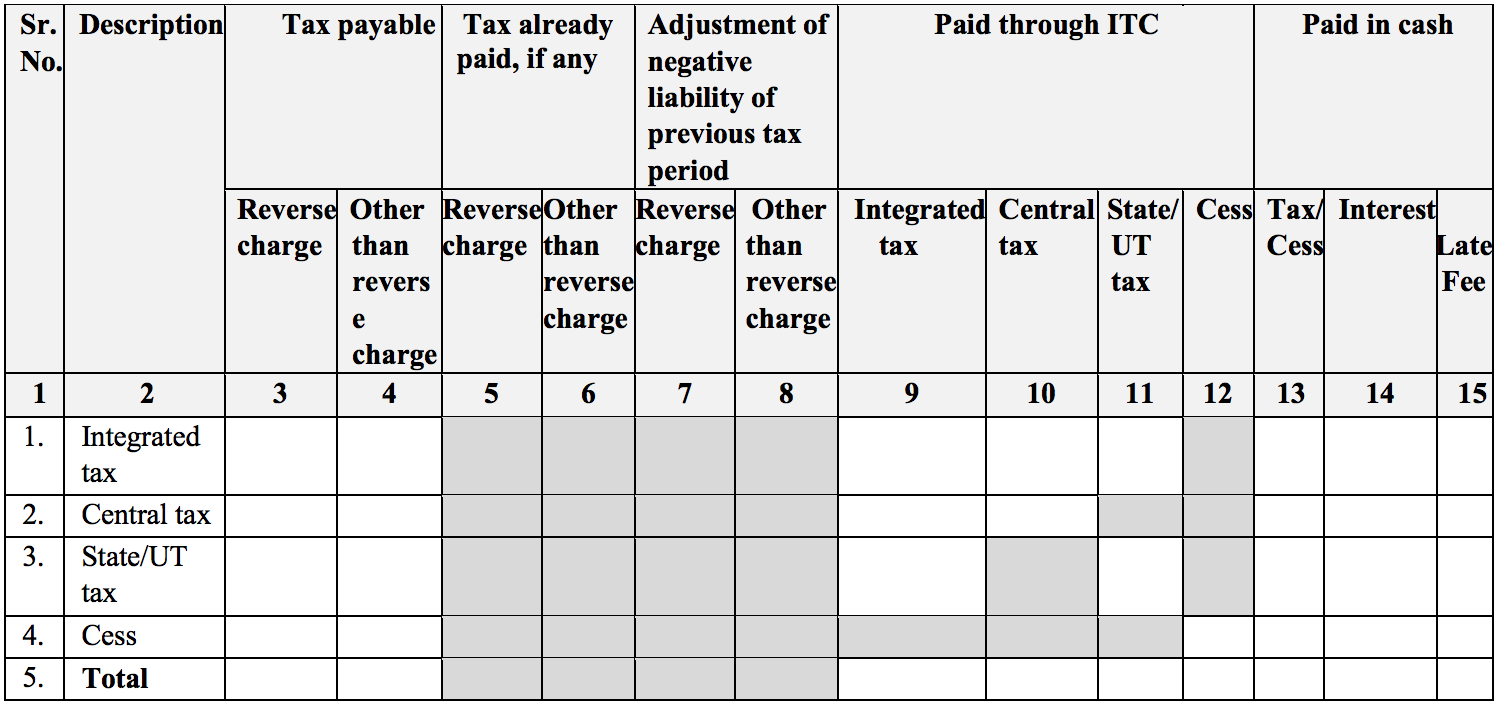
This part of the form is for details related to your tax payments. You are required to enter the amounts of tax payable, tax paid, adjustment of negative tax liability accumulated during the previous tax period, tax paid through ITC, and tax paid in cash for the following:
Integrated tax
CGST
SGST/UGST
Cess tax
Part 7: Verification

The final part of this form is verification. Filling in and signing the final part of the form will verify and authenticate the return either through a digital signature certificate (DSC) or by using an Aadhar-based signature verification mechanism.
Form GST PMT-08
GST PMT-08 is the form that must be filed on a monthly basis, when making payments of self-assessed tax. Here is a detailed explanation of each section of the form:
Part1 and 2: General details

The first two parts of this annexure are for your general details: GSTIN, full legal name, trade name, ARN (Application Reference Number), and the date of filing.
Part 3: Summary of self-assessed liability and ITC availed

In this section, you are required to enter the relevant amount of integrated tax, CGST, SGST/UGST, and cess tax for the following:
Any liability to pay taxes besides those under reverse-charge.
Any liability to pay tax under reverse-charge.
The amount of ITC that you have availed.
Part 4: Payment of tax
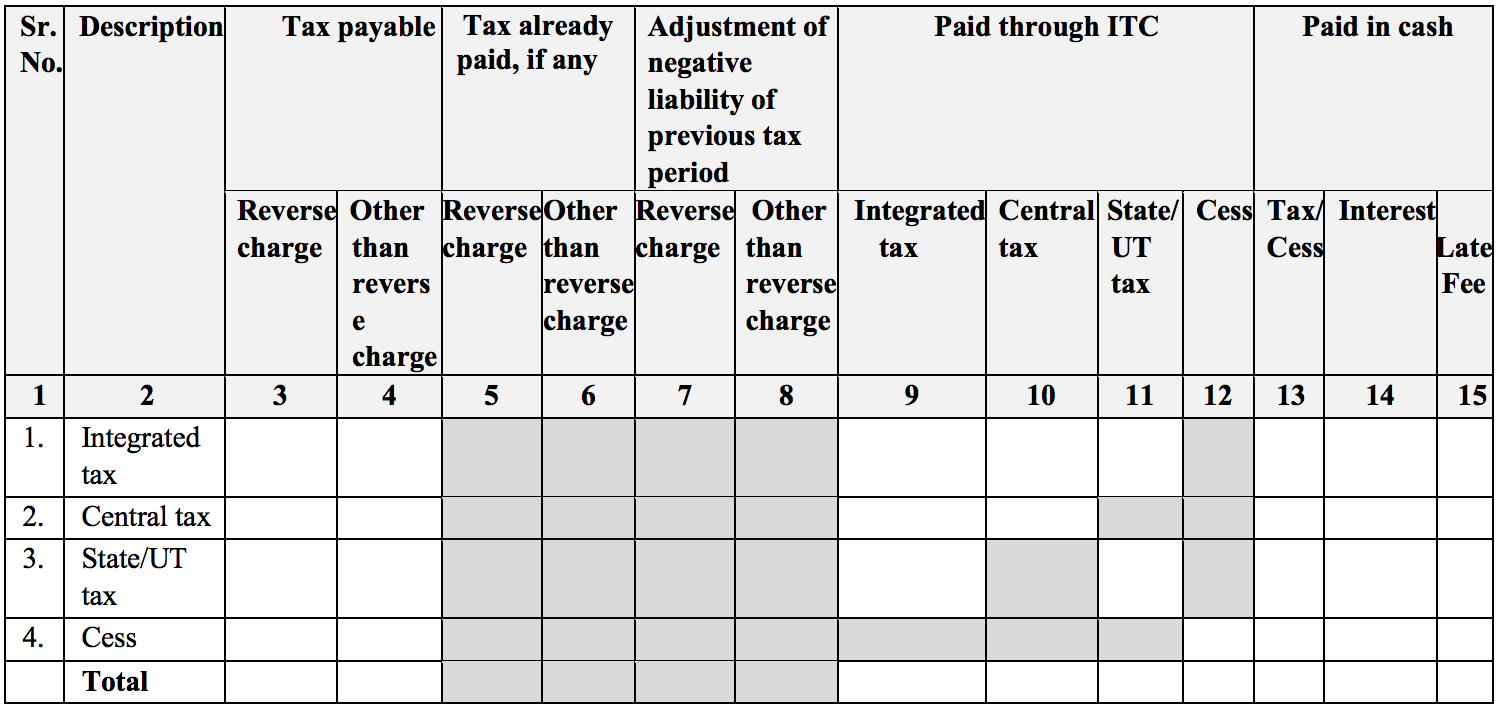
This part of the form is for details related to your tax payments. You are required to enter the amounts of tax payable, tax paid, adjustment of negative tax liability accumulated during the previous tax period, tax paid through ITC, and tax paid in cash for the following:
Integrated tax
CGST
SGST/UGST
Cess tax
Part 5: Verification

The final part of this form is verification. Filling in and signing the final part of the form will verify and authenticate the return either through a digital signature certificate (DSC) or by using an Aadhar-based signature verification mechanism.

